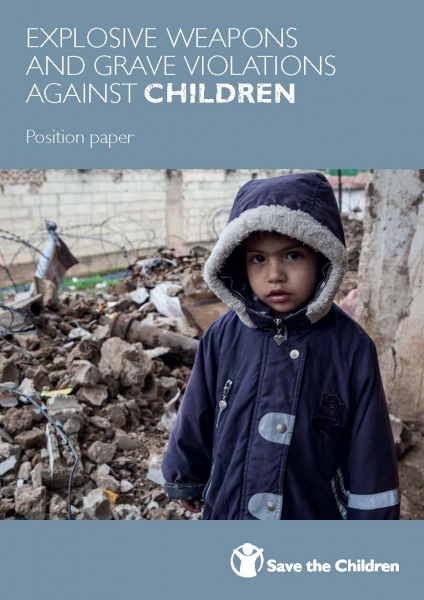
UN Security Council Resolution 1612 on the protection of children affected by armed conflict identifies six grave violations against children because of their especially egregious nature and severe impact on a child’s wellbeing. A new paper by Save the Children shows how the use of explosive weapons in populated areas leads directly to grave violations against children and calls for stronger policy, practice and international standards to save children’s lives, protect them from injury and lifelong psychological scars, and to ensure that children are not denied access to schools and health care.
The publication ‘Explosive Weapons and Grave Violations against Children’ focuses on the link between the use of explosive weapons and three of the grave violations:
* killing or maiming of children,
* attacks against schools or hospitals, and
* denial of humanitarian access for children,
Explosive weapons also contribute to the other three violations, recruitment or use by armed groups, abduction, and rape and other forms of sexual violence, but these links are not discussed in this paper.
The paper notes that explosive weapons are responsible for killing and injuring thousands of children in at least 41 countries over the past two years. In Syria, children are being killed and maimed by explosive weapons almost daily. While there is no exact figure for how many of the casualties are children, hospital reports show that an increasing number of children are being admitted with burns and injuries from explosions. A member of the Save the Children Syria response team said that between September 2012 and March 2013 they interviewed more than 130 children and their families, nearly all of whom cited the constant threat and stress of shelling, bombing and bombardment of their homes, schools and communities as their primary reason for fleeing Syria. Many saw friends and relatives killed by explosive weapons; some children had been injured themselves and spoke of their schools and local hospitals being attacked.
An estimated 2,400 schools have been damaged by the conflict in Syria. One UN survey found that one-fifth of schools in Damascus have been damaged or destroyed, in Idlib province, 60% have been damaged. Thousands of schools are being used as shelters by civilians, some of these are then being targeted by armed actors, as when, for example, a government jet dropped a ‘barrel bomb’ on a school that was sheltering 200–300 people, killing a dozen, including children. In some cases schools are used by armed actors as barracks which can make them a legitimate target of attack.
Delivery of humanitarian assistance in Syria has been an ongoing challenge, too. Insecurity and constant bombardment are compelling obstacles to reaching the millions who need assistance. As another recent study shows, explosive weapons are a key threat to aid workers. Explosive weapons also damage roads and buildings, key infrastructure for the delivery of humanitarian aid.
“We left Syria because of the shelling. Every night I’d wake up scared. I’d rather die here from the bad conditions than die in Syria. I wouldn’t be alive if I was still in Syria.” ‘Ali’, 12 years old.
‘Ali’s’ testimony (name changed to protect identity), and those of many other children are a sobering reminder that these grave violations are committed on an ongoing basis.
Save the Children is urging states, NGOs, international organisations and other relevant bodies to respond to the harrowing testimonies provided in this paper by taking action to prevent and reduce the impact of explosive weapons on children and other civilians.
In line with the call of the UN Secretary-General to take active steps to address this fundamental humanitarian issue, Save the Children recommends, among other measures, that:
- Parties to conflict that use explosive weapons in populated areas should refrain from further use, recognise the impact of explosive weapons on children, acknowledge responsibility for any resulting harm, and develop risk education for children and their communities affected by explosive weapons to enhance security for children living with this threat.
- The UN Security Council should allocate to an appropriate UN body the mandate to create a mechanism to ensure open and accurate reporting of loss of life, injury, impact on infrastructure and environmental damage when explosive weapons are used in populated areas. Such a mechanism and follow-up responses must be adequately resourced, and information should be disaggregated by age, gender, nationality and ethnic group.
- There should be an increase in funding for child protection, education and mental health programmes that can respond to the psychological needs of children and families affected by the use of explosive weapons in populated areas, in order to prevent long-term negative effects on the cognitive, emotional and social development of the coming generations.
